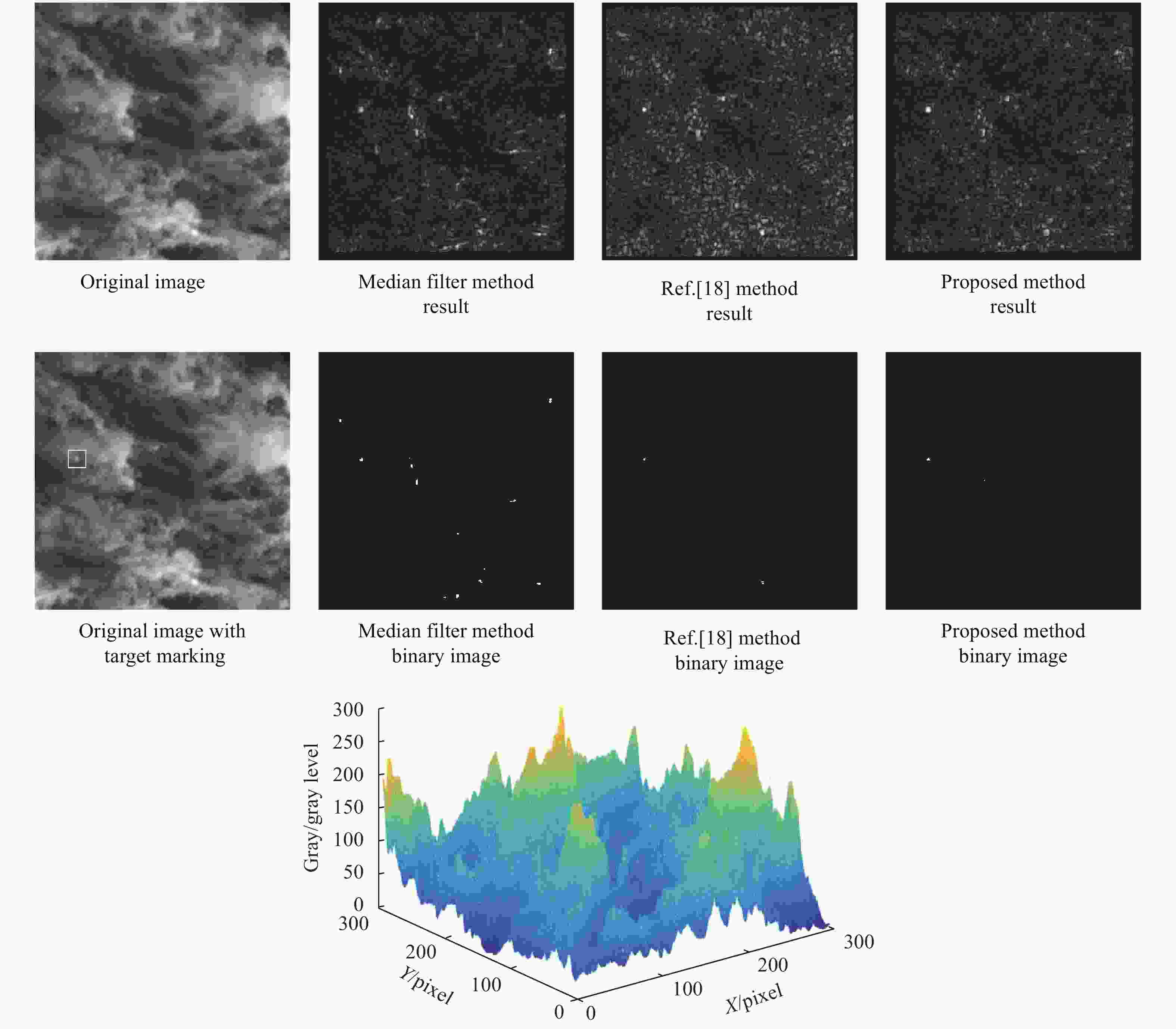-
红外弱小目标自动检测技术是红外预警技术、导弹导引头目标寻的技术、光电砖塔目标检测识别技术和光电反潜技术的瓶颈。困难在于低信噪比条件下红外目标无形状、在像平面上占比较少,背景复杂 [ 1- 2] 。另外,成像过程中,红外传感器的非均匀成像导致的“鬼影”现象对目标检测影响也很大,红外弱小目标往往湮灭在多种背景杂波及噪声中。自20世纪红外传感器发明后,全世界的学者就进行了大量的研究,重点就在红外图像的目标检测算法技术上 [ 3] 。提出的算法大致分为:跟踪前检测方法(简称DBT)和检测前跟踪方法(简称TBD)。
其中,检测前跟踪方法优势在于可利用视频信息检测更低信噪比的目标,缺点是需要搜索目标可能的轨迹,然后判断目标的实际运动轨迹,计算量较大、实时性差 [ 3- 4] ,比如基于动态规划的方法 [ 5] 、基于多级假设检验方法和基于三维时空域滤波的方法等。跟踪前检测方法优势在于运算量小,但对信噪比非常低的目标无能为力。比如基于空间滤波的方法 [ 6] 、各种频域高通滤波方法 [ 7- 8] 以及基于人类视觉响应的显著度检测方法等。参考文献[ 9]中提出一种杂波环境中提取雷达微弱目标的方法,采用两级门限方法获取目标序列,再采用逆向推导方法获取目标运动轨迹。参考文献[ 10]中提出一种基于引导滤波和核相关的红外背景下微弱目标的检测算法,是一种改进型的红外目标检测前跟踪方法。参考文献[ 11]提出一种基于子空间方位稳定性的弱小目标检测方法,针对水下未知目标的检测和方位估计,采用基于信号协方差矩阵进行特征分解的方法,提高了对弱目标的检测能力。
文中提出一种DBT算法,基于最恰对比度显著性分析进行红外弱小目标检测。该技术已被应用于导弹末制导及红外侦察预警系统。在滑动窗口中构造基于最恰对比度的非线性处理函数,可有效处理图像中背景边缘内容,使之产生较小的虚警,同时不影响目标的检测性能。文中采用了多组仿真图像,从指标及图像处理效果两方面分析了提出算法的有效性。结果表明,该方法不仅在目标检测指标方面优于其他算法,在图像处理效果方面也较理想,可有效提高目标检测的概率。
-
选择性注意机制是视觉系统的重要特征,这种机制可以将视场中的信息按照关键性排序的方式进行高速处理,获取重要局部区域,使得人类可以迅速将注意力集中至该区域 [ 15- 16] 。这些区域的特征即具备较高的对比度。人类的这种视觉特性对计算机视觉而言启发较大,可有效剔除无效信息,从而将计算资源集中至特征明显区域。
受生物的注意力机制启发,一些学者提出将图像局部领域之间的对比度作为特征,再从全局出发进行局部区域特征检测的方法,即显著度方法。当前基于显著度的视觉算法主要有频谱残差方法、视觉注意方法等。
视觉显著度的方法如 图1所示:首先定义3×3的正方形块,每个块的大小都为 m× mpixel,中心块为M,周边块从M1至M8。
基于生物视觉的研究成果,采用对比度来衡量生物对目标识别的特征,对于图像块的像素中心坐标为( a, b)的点,定义与第 c个领域块的对比度为:
式中:
$\max \left( {I_M^{\left( {a,b} \right)}} \right)$ 为中心像素块M中像素灰度值最大值;${\rm{mean}}\left[ {I_{{M_c}}^{\left( {a,b} \right)}} \right]$ 为第 c个领域图像块中像素灰度值的平均值。定义像素中心坐标为( a, b)处的领域最大对比度为:
即对于8个领域图像块进行遍历,寻找最大对比度的值,作为该点( a, b)的领域最大对比度值。
通过全图计算最大领域对比度值,可获得感兴趣区域,为进一步寻找目标极大缩小搜索范围。
图像的感兴趣区域的显著图提取方法按照二值图的分割方法完成,计算公式如下:
式中:
${\bar{D}}$ 为最大领域对比度值的均值;${\sigma _{D}}$ 为最大领域对比度值的离散度(1 σ)。 -
基于最大对比度算法的检测性能在图像滑动块位于红外图像的背景变化剧烈,当目标正好位于该处时,检测性能较差。这是因为最大对比度算法在背景剧烈变化处(比如海天交界处)时,在凸显目标的同时也放大了边缘纹理的对比度,导致目标被周围图像信息干扰,有时甚至提取不出含目标的图像区域块。另外,提取的感兴趣区域面积过大,也会导致图像处理算法实时性较差。
从上节公式出发,类似可得:
其中,求最大对比度的计算过程被求中值对比度的计算过程取代,这样做的好处是当滑动图像块在边缘扫描时,对比度不显著。另外,当目标被扫描时,可以获得更高的对比度。在完成基于最恰对比度的过程后,获取全图的感兴趣区域的方法依然是阈值分割方法。
下面对不同类型区域的对比度解算过程进行分析:
(1)图像滑动块包含目标时,背景位于起伏较小的区域
如 图2(a)右侧滑动图像块,领域块为平滑的背景,因此对领域块求取的8个对比度值差异很小,于是,求中值后得到的结果与最大对比度算法得到的结果基本一致,目标感兴趣区域块的提取不受影响。
(2)图像滑动块不包含目标时,背景位于起伏较小的区域
如 图2(a)左侧滑动图像块,依然为平滑的领域块,对领域块求取的8个对比度值差别依然不大,求中值后的结果与最大对比度算法也保持一致,不会增强背景对比度值。
(3)图像滑动块包含目标时,背景位于图像边缘区域
如 图2(b)左侧滑动图像块,采用传统最大对比度值的计算结果会增强边缘对比度,而采用最恰对比度算法在抑制边缘对比度的同时,可以增强目标。
(4)图像滑动块不包含目标时,背景位于图像边缘区域。
如 图2(b)右侧滑动图像块,采用文中提出的最恰对比度算法处理得到的边缘被极大抑制。在后续实验部分会继续验证该结论。
算法流程如 图3所示。
-
文中提出的算法在笔记本电脑上实现,电脑配置为:Intel Core i5,主频2.50 GHz,内存为4.00 GB,32位操作系统。操作系统为Windows 7,开发软件为Matlab2012。
实验采用18帧存在弱小红外目标的图像进行有效性检测分析,其中,地面背景图像1帧,海天交界背景5帧,海洋背景1帧,天空背景11帧。滑动图像块大小为12×12。采用局部均值信噪比、局部均值信噪比增益和背景抑制因子衡量算法 [ 17] 对红外弱小目标的检测能力。计算公式为:
式中:mean(·)为求均值的函数;
${{{I}}_{{\rm{Local}}}}$ 为算法处理后局部区域的图像函数;${{\bar{I}}_{{\rm{Local}}}}$ 为算法处理后局部区域的图像均值;${\sigma _{{\rm{Local}}}}$ 为算法处理后局部区域的图像灰度离散度;${{{P}}_{{\rm{SNR}}}}$ 为算法处理后局部区域信噪比值;${{{P}}_{{\rm{SNR0}}}}$ 为算法处理前局部区域信噪比值;${\rm{GAI}}{{\rm{N}}_{{\rm{SNR}}}}$ 为局部均值信噪比增益;BSF为背景抑制因子,滤波前的噪声比滤波后的噪声。从实验结果如 表1~ 4和 图4~ 图7所示,文中提出的方法比中值滤波方法的效果好很多。与参考文献[ 18]提出的方法相比,在大部分情况下效果更好。通过观察3种方法的二值图可知,文中提出方法的检测虚警率极低,而中值滤波方法及文献提出的方法虚警率较高,对目标检测效果较差。从4组实验的三维灰度曲线可知,目标基本湮灭在起伏的背景中,因此,目标比较难以检测,3种方法抑制背景噪声的能力相当,但文中提出的方法对目标的增强效果显著,有利于检测目标。
Picture 1 SCR SCRgain BSF Median filter method 7.5 5.7 3 Ref. [ 18] method 6.9 5.3 2 Proposed method 10.2 7.8 2.7 Table 1. Experimental results 1
Picture 1 SCR SCRgain BSF Median filter method 13.1 9.8 2.9 Ref. [ 18] method 9.0 6.8 3.5 Proposed method 13.6 10.3 2.8 Table 2. Experimental results 2
Picture 1 SCR SCRgain BSF Median filter method 6.2 4.7 2.4 Ref. [ 18] method 8.1 6.2 2.6 Proposed method 9 6.9 2.6 Table 3. Experimental results 3
Picture 1 SCR SCRgain BSF Median filter method 9.9 3.2 2 Ref. [ 18] method 6.2 2 1.8 Proposed method 11 3.5 1.8 Table 4. Experimental results 4
由 图4~ 图7可知,该方法用于导弹末制导及红外侦察预警中,应用效果较好,可在海面、天空背景下有效检测弱小目标,提高末制导的目标检测概率,提升目标检测的侦察预警距离,为告警拦截系统争取反应时间。
-
通过红外弱小目标特性及传统显著度检测方法的分析,文中提出一种基于最恰对比度显著性分析的红外弱小目标检测方法。采用了滑动窗口的非线性滤波技术对图像进行基于最恰对比度的显著度处理,与传统方法相比,提出的方法可以有效增强目标的对比度。进行了大量的仿真实验及半仿真实验,结果表明,提出的方法虽然在背景抑制方面能力有限,但在目标增强方面作用很大,可有效提高目标的检测能力。
Detection of dim and small infrared targets based on the most appropriate contrast saliency analysis
doi: 10.3788/IRLA20200377
- Received Date: 2020-09-24
- Rev Recd Date: 2020-11-12
- Available Online: 2021-05-12
- Publish Date: 2021-04-30
-
Key words:
- infrared image sequence /
- dim and small target detection /
- significance analysis /
- optimal contrast
Abstract: Aiming at the current situation of dim target detection in infrared image, a dim and small target detection method based on the most appropriate contrast saliency analysis was proposed. In sliding serial port, the non-linear processing technology was used to process the image, which avoided the saliency produced by traditional saliency analysis algorithm when processing the image at the scene edge. The problem of value interference does not affect the ability of target extraction in the target area. A large number of hardware-in-the-loop simulation experiments were carried out. The results show that although the proposed method can not improve significantly in the background suppression factor, the performance of target detection in the two indicators of mean signal-to-noise ratio and signal-to-noise ratio gain of the proposed method are significantly enhanced. And among the three methods of image processing, the effect is the best.





























 DownLoad:
DownLoad:







